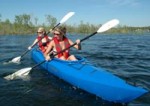
A recent Coast Guard report on boating safety noted: “Nearly 75 percent of the 736 people who died in boating accidents in 2009 drowned, and 84 percent of those victims reportedly were not wearing a life jacket,” said Rear Adm. Kevin Cook, the Coast Guard’s director of prevention policy. “The two most important things boaters can do to prevent the loss of life is to wear a life jacket and take a boater education course.”
Once upon a time we all called our PFDs (Personal Flotation Devices) life savers or life vests. The idea was that if you wore them, they just might save your life. Unfortunately in our bureaucratic and litigious society someone pointed out that life vests didn’t always save lives and calling them life vest or worse life savers might imply a certain liability in those cases where lives were not saved. So therefore, we now have PFDs. Of course, everyone still calls them life jackets, even the Coast Guard, who writes the regulations for PFDs.
To an extent these figures demonstrate the naysayers point. If 84% of drowning victims were not wearing life jackets then 16% were wearing life jackets and drowned anyway. Nevertheless I will keep wearing my life jacket.
The wearing of life jackets is not just an issue for recreational boaters. Within the last week, gCaptain covered the death of a ships mechanic and a Chief Engineer whose lives probably would have been saved if they were wearing life jackets.
I fear that I am stating the obvious here, yet based on the body count of those who chose not to wear PFDs, perhaps not. This week, I am going kayaking with my family on Lake George, a large and beautiful lake in the Adirondack Mountains of New York state. We will be wearing life jackets. So far this year two paddlers have died. One kayak was hit by a power boat. The kayaker was seriously injured by the collision but died of drowning. He was not wearing a life jacket. In another case a paddler in a canoe drown when he was capsized by power boat wakes. he wasn’t wearing a life jacket either.
Whatever one calls them, PFDs are still lifesavers.

The term PDF was introduced by the USCG many years ago, g-d knows why! Fortunately within the last couple of years they returned to the term ‘LIFEJACKETS’. This is what the rest of the world calls them where term PDF is unknown and should therefore not be used. The boxes on internationally manned cruise ships are marked LIFEJACKETS. So please lets drop this PDF business once and for all!! Thank y’all.
Good Watch.
You see I got it wrong didn’t I!! It is PFD and is a silly term, so again LIFEJACKETS please.
Good Watch.
Took a second look when I saw PDF with Life Savers text! Good way to get someone’s attention!
You’re right – Life jackets/PFDs are so important for water safety. And they need to be worn properly, not just stowed on the boat.
Good reminder for all boaters with just a few more weeks in summer.
Jane
Good reminder on the importance of life jackets. People should also make sure that they are the right size (adult versus children), and worn securely. It doesn’t do any good to have them on the boat, in storage, when out for a day of water sports or pleasure boating.
Even with the season ending soon, safety should always come first.
Jane Warren
http://www.towabletubesdirect.com/blog/safety-rules-weekend-water-sports/
Jane, I can’t believe that I was that fumble fingered. Thanks for pointing it out.
Peter, it is funny, the Code of Federal Regulation requires Personal Flotation Devices, PFDs, but even Coast Guard admirals call them life jackets. Even they realize that no one in the real world speaks CFR.
Speaks CFR, love it must remember that one. Thanks Rick and
Good Watch
PFDs are an absolute essential to every boat! It’s one of those accessories you can’t be without for the simple fact that it saves lives. People who don’t want to wear them are asking for trouble.